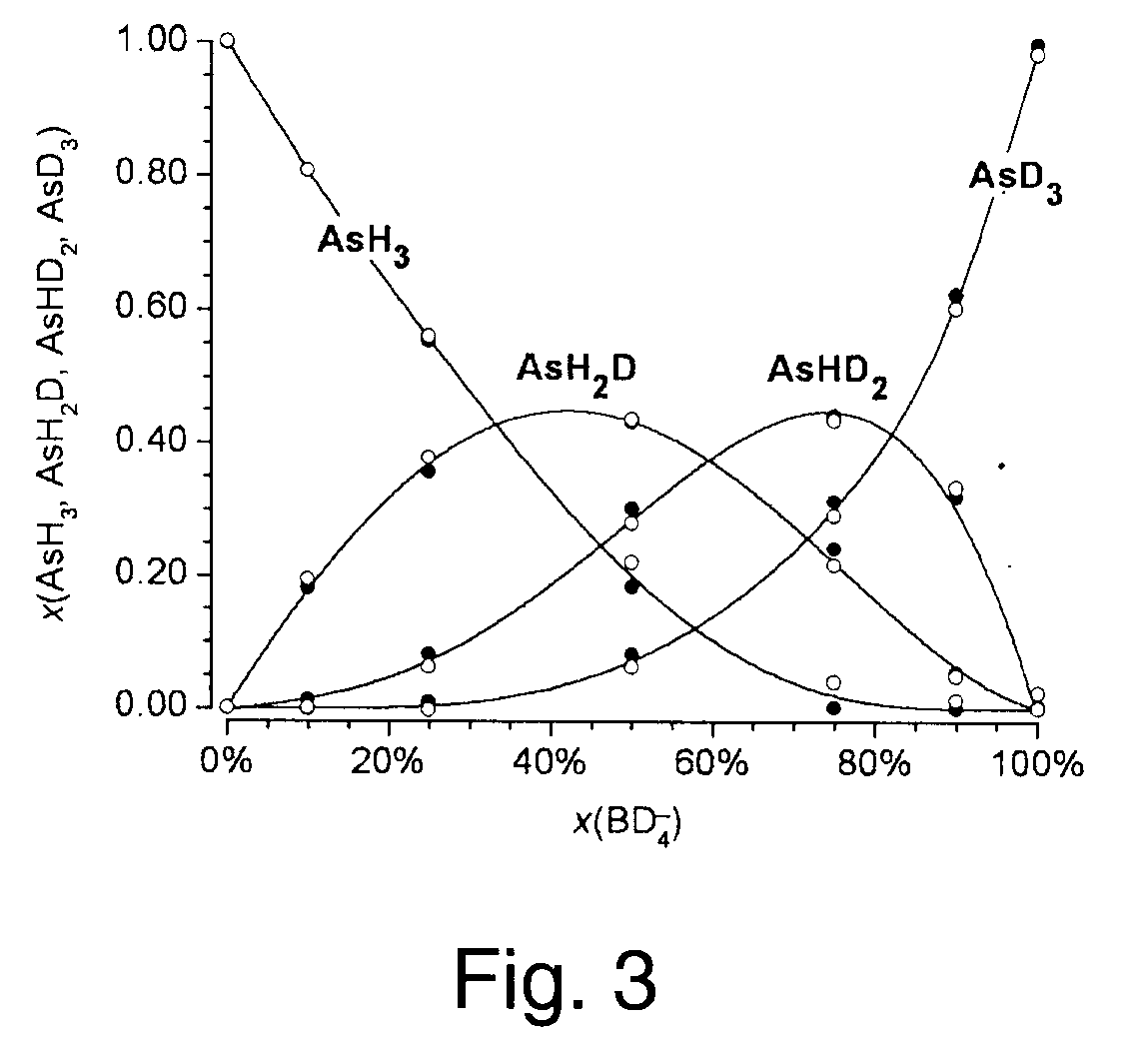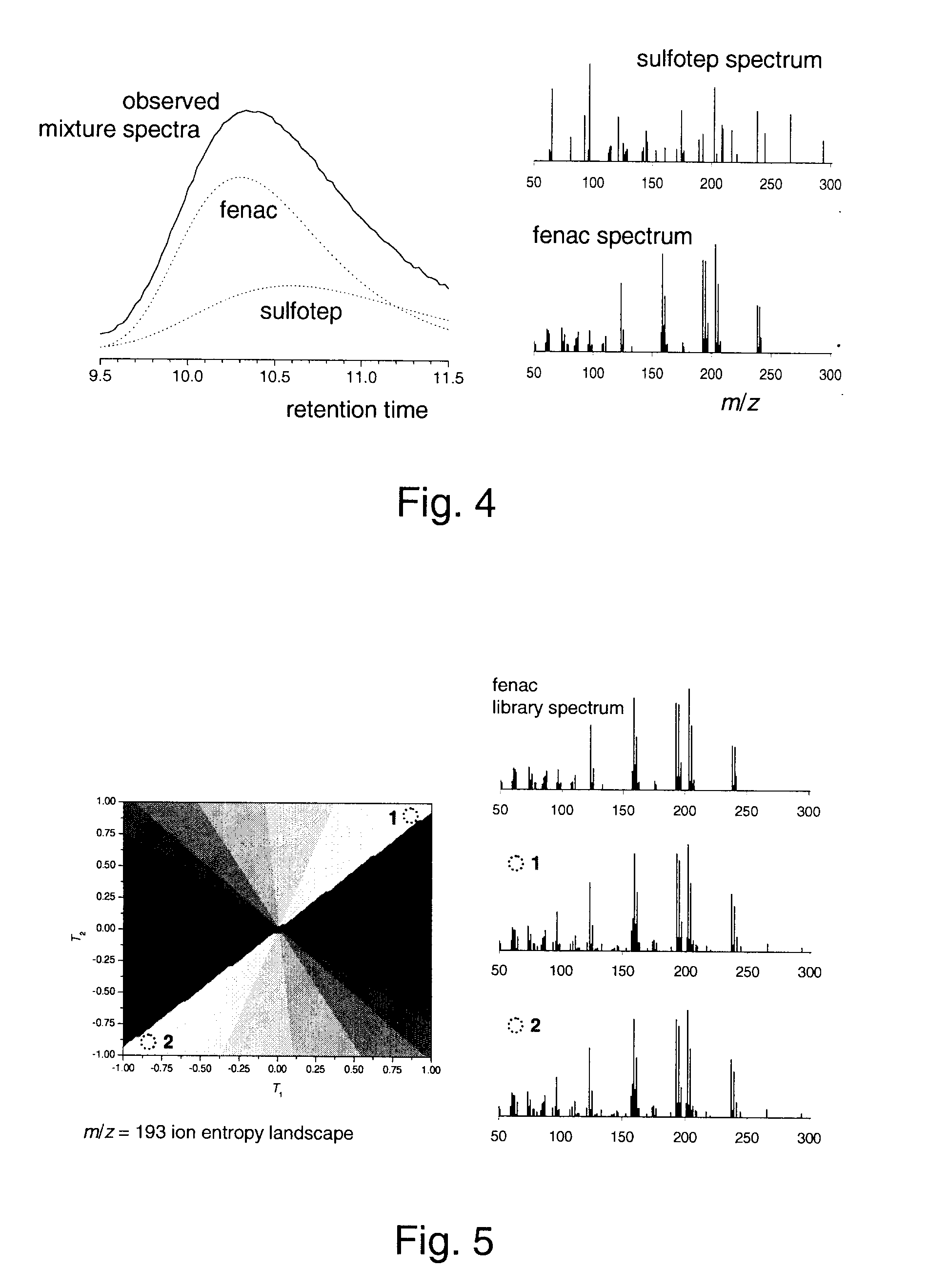Blind Extraction of Pure Component Mass Spectra from Overlapping Mass Spectrometric Peaks
a mass spectrometry and pure component technology, applied in the field of extraction of pure component mass spectra, can solve the problem of significantly faster minimization than prior art methods
- Summary
- Abstract
- Description
- Claims
- Application Information
AI Technical Summary
Benefits of technology
Problems solved by technology
Method used
Image
Examples
example 1
Extraction of Real-World Unknown Component Spectra
[0046]This example illustrates the general applicability of blind entropy minimization to the extraction of unknown component mass spectra from the mass spectra of unresolved or partially resolved systems. In this example, blind entropy minimization was conducted in a manner described in Zhang, 2003 using a stochastic optimization technique.
[0047]Materials and Methods
[0048]Chemicals. The following reagents were used: NaBH4 pellets (Alfa Aesar, Word Hill, Mass.); NaBD4 pellets (99% D, Cambridge Isotope Laboratories, MA); 37%, DCl in D2O (99.5% D, Aldrich); 30% NaOD in D2O (99% D, Aldrich) and D2O (99% D, Aldrich). A solution of NaBH4 prepared in H2O, was stabilized by adding NaOH up to 0.1 M final concentration. A solution of NaBD4 (0.25 M), prepared in D2O was stabilized by adding NaOD up to 0.1 M final concentration.
[0049]An enriched isotopic standard solution of 260 μg mL−1 82Se(IV) in HNO3 aqueous media (Oak Ridge National Laborat...
example 2
Entropy Landscape Surface Properties for a Simulated Two-Component Pesticide System
[0088]Example 1 demonstrates the utility of blind entropy minimization for the extraction of unknown component mass spectra from the mass spectra of unresolved or partially resolved real-world systems. Example 2 describes the use of blind entropy minimization in the context of extracting individual mass spectra of a simulated two-component pesticide mixture. Specifically, Example 2 demonstrates the properties of entropy surface landscape and its advantages in mass spectral deconvolution.
[0089]In an arbitrary chosen system of two components, the extracted mass spectra (not necessarily pure) is a function of the T vector (containing two variables a and b):
A=(ab)·∑·VTconst(12)
[0090]Hence, the entropy landscape of the extracted mass spectra, A, can be explored as a two-variable function:
S=f(a,b) (13)
[0091]This two component system entropy surface landscape can be visualized as a 3D scatter plot. For this...
example 3
Extraction of Simulated Four-Component Pesticide System
[0093]Unfortunately, visualizing the entropy landscape in more component systems is challenging as is any multidimensional visualization task. In this case, the four components are pesticides aldrin, bifenox, bromophos and captan. Chromatographic elution of the four pesticide mixture was simulated in silico. For this purpose, reference spectra of the pure compounds were obtained from the NIST database, and an overlapping chromatographic elution profile was then established with added noise. Concentration of the each component in this mixture was equal and severe chromatographic overlap was created. The obtained total ion current chromatogram is shown in FIG. 6.
[0094]From the chromatogram of FIG. 6, a mass spectrum was extracted for every given time interval (scan) and the band-target entropy minimization was performed without using any prior knowledge of the system. Four components were identified and their extracted spectra (FI...
PUM
 Login to View More
Login to View More Abstract
Description
Claims
Application Information
 Login to View More
Login to View More - R&D
- Intellectual Property
- Life Sciences
- Materials
- Tech Scout
- Unparalleled Data Quality
- Higher Quality Content
- 60% Fewer Hallucinations
Browse by: Latest US Patents, China's latest patents, Technical Efficacy Thesaurus, Application Domain, Technology Topic, Popular Technical Reports.
© 2025 PatSnap. All rights reserved.Legal|Privacy policy|Modern Slavery Act Transparency Statement|Sitemap|About US| Contact US: help@patsnap.com



